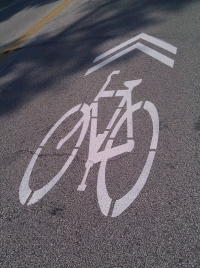What is "Practicable"?

What is “practicable”?
Most people would agree that a government should not do things that endanger its citizens’ lives, or unduly restricts their freedom, or their ability to improve their own lives. It’s also generally accepted that societies, through their governments, have a responsibility to reasonably prohibit their citizens from infringing on others’ rights to “life, liberty, and the pursuit of happiness.”
One place where government has a clear role in protecting the safety and freedom of its citizens, and in regulating their behavior towards each other, is in the public commons. The simplest example of this is on our public roads. Everyone has a right to use the road to get wherever they need to go, as long as they don’t unreasonably infringe on others’ rights to do the same.
How much is our society obliged to do to make bicycling safer? Do we have to make it safer for everyone; including novice cyclists, or children? Widespread cycling has many proven social and environmental benefits for public health and creating more “livable” communities: should we – through the laws, policies and investments of our government – also strive to make cycling easier, more convenient, and more popular? What if making cycling safer and easier makes it a bit harder to get around by car? What if it makes it a lot harder?
It’s not always necessary to make hard political decisions to make cycling safer and more acceptable. It can be done with simple changes to existing laws that make everyone’s lives easier.
Thankfully, in 2006 the Ohio Bicycle Federation did the difficult political work to include in Ohio’s traffic law examples of when cyclists’ obligation to ride “as far to the right as practicable” does not mean that we must always share the lane with motorists:
“4511.55 Operating bicycles … on roadway.
(A) Every person operating a bicycle … shall ride as near to the right side of the roadway as practicable …This…does not require [cyclists] to ride at the edge of the roadway…when [it is] necessary to …avoid fixed or moving objects, parked or moving vehicles, surface hazards, or if it otherwise is unsafe or impracticable to do so, including if the lane is too narrow for the bicycle and an overtaking vehicle to travel safely side by side within the lane.” (emphasis added)
Here are some other simple things that we could do to make cycling safer, easier, and more enjoyable. They would not infringe on others’ rights to use the public roads; in fact, they would benefit all road users:
All road surfaces should be made smoother, and thus safe for cycling, with no longitudinal variances greater than 1”.
Examples of this include: railroad crossings; bridge decks; concrete-asphalt interfaces such as storm-drain aprons and bus-stop pads; and any temporary pavement repairs (such as steel plates).
Traffic control devices should accommodate cyclists.
Induction and video vehicle detectors --which serve to operate traffic signals when vehicles are detected waiting for them -- should recognize bikes. Amber light times should be calibrated for approach speed of 12 MPH. Red light times should not be excessively long (as are most downtown Cleveland signals) to make compliance reasonable.
Police should enforce existing traffic laws vigorously, equitably and consistently.
Bicyclists who ride illegally should be warned, and then ticketed, and motorists who endanger cyclists should be cited appropriately. Drivers’ Education and police officers’ training should include information about cyclists’ rights.
Bicycle education should be available to all citizens, but especially to those most likely to pose risks to themselves or others.
Bike Drivers’-Ed courses should be offered widely, and required for motorists convicted of any infraction involving a cyclist; and for cyclists cited for illegal operation.
Curb lanes that are too narrow for cyclists to safely share with motor vehicles should be made evident where possible.
Bicyclists usually can not share with motorists lanes that are less than 15’ wide – this could be made clear with signage in most cases.
Bicycle advocacy is a responsibility for every cyclist; not only through political action, but every time we ride.
Jim Sheehan
Jim Sheehan is Executive Director and a founding member of the Ohio City Bicycle Co-op, a non-profit bicycle education facility in Cleveland Ohio. He was region 4 director of the League of American Bicyclists from 2006-2009, has been a League Cycling Instructor since 2003, and is a founding member of Bike Cleveland (and previous local advocacy groups, since 1992). He has been a bike mechanic, messenger, tourist, racer and (as often as possible) a bike commuter. He lives with his wife in Shaker Heights, where he enjoys mountain biking on nearby deer trails in the company (and at the "unhurried" pace) of their 12 year old beagle, Fressie.
